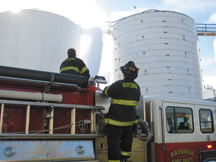When the sirens went off on Oct. 22, the Bayonne Fire Department leaped into action. Although they all knew it was a drill, they also knew that they needed to hone their skills for when the sirens go off for real.
So fire teams rushed to the Hook Road location of the International Matex Tank and Terminal (IMTT), a chemical company.
IMTT is one of 25 facilities in Northern New Jersey the state office of Homeland Security considers vulnerable, and the plan would provide a layer of response in case of a large disaster.
“Every annual drill is a learning experience and directly affects the training for the upcoming year.” – Michael Morganti
________
These drills help improve emergency response times and provide practice for communicating with first responders for quick and safe patient evacuation techniques.
Five years ago, IMTT and other plants in New Jersey worked out safety agreements with the state that would help them follow stricter guidelines regarding safety, using the American Chemistry Council safety standards as a base. New Jersey is third in the country for chemical production, with two of the eight facilities located in Hudson County – IMTT in Bayonne and Kuehne in Kearny.
Last year, the federal and state Department of Homeland Security set up a new master response plan for Northern New Jersey that coordinates state response to large scale emergencies.
For smaller disasters, such as the pretend fire IMTT staged, local agencies such as the Bayonne Police Department, McCabe Ambulance, IMTT, the Fire Department and the staff at BMC must be prepared.
Although Bayonne emergency services would be involved in any kind of fire or other disaster at IMTT, the company also maintains its own firefighting force and other emergency response teams.
Coordinating
These drills, according to Fire Chief Greg Rogers, serve as an opportunity for the facility and a multitude of response agencies to exercise emergency response practices annually.
The IMTT Emergency Response Team, the Bayonne Fire Department, the Bayonne Police Department, local EMS provider (McCabe Ambulance), the Office of Emergency Management, the Hudson Regional Health Commission, the Division of Fire Safety, the Jersey City Fire Department, and a multitude of additional response and support agencies all gathered in participation of the mock emergency.
This year’s drill fortified interagency communication, coordination, and mitigation practices, and involved three separate simultaneous incidents. A mock tank fire and foam operation, a mock rail car incident, and a mock product spill were all handled under the joint efforts of the multiple agencies involved.
“IMTT-Bayonne is pleased to have had 17 organizations comprised of local and state agencies and various mutual aid companies participate in our annual drill,” said Richard Fisette, IMTT terminal manager.
While the events that took place on Sept. 11, 2001 highlighted the need for drills of this kind, the federal government began to set up systems for large scale emergencies after several international events in the mid-1990s.
“Our annual drill is the opportunity to evaluate our response capabilities, test new and old strategies, and ties the training together that is conducted by us and our response partners throughout the year,” said Michael Morganti, IMTT Bayonne fire brigade chief.
